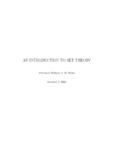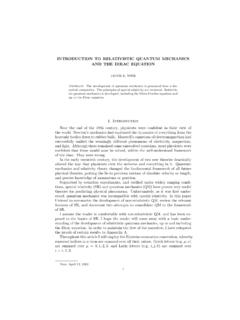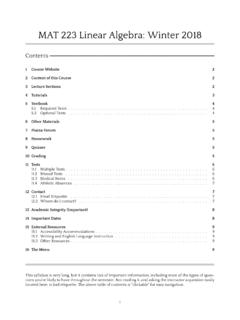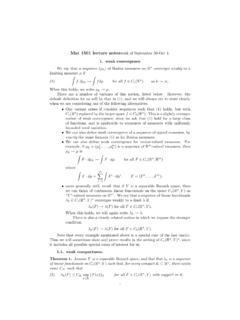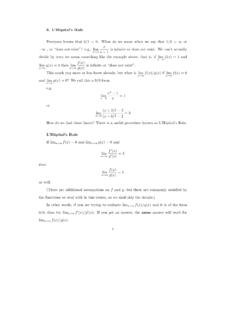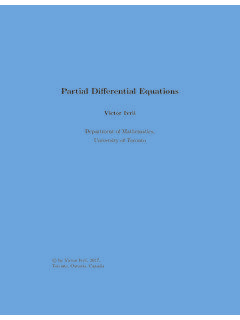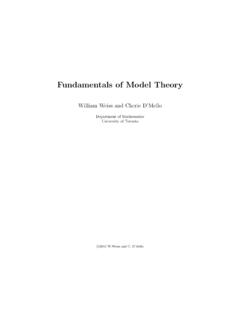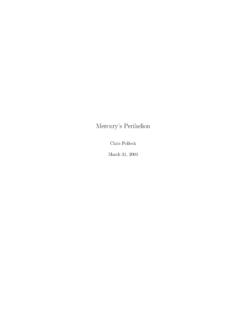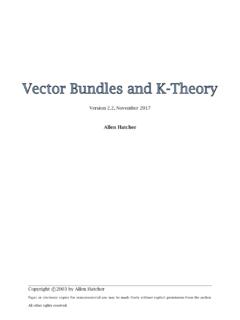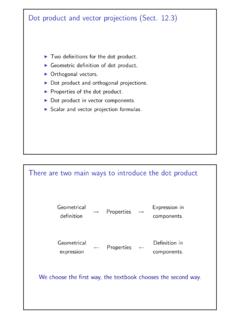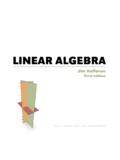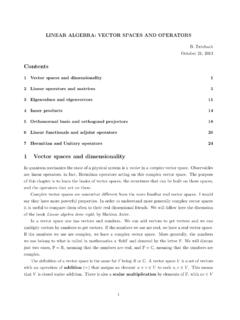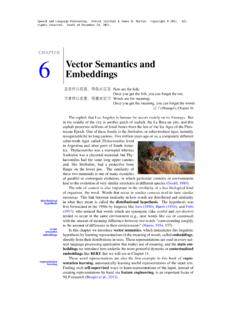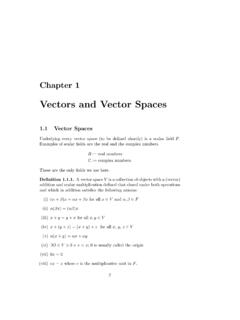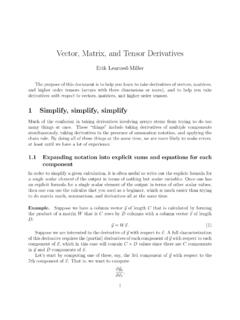Transcription of What is a Vector Space? - University of Toronto
1 what is a Vector Space? Geoffrey ScottThese are informal notes designed to motivate the abstract definition of a Vector space tomy MAT185 students. I had trouble understanding abstract Vector spaces when I took linearalgebra I hope these help!Why we need Vector spacesBy now in your education, you ve learned to solve problems like the one 1:Findx1,x2,x3 Rthat solve the system of linear equations3x1+ 2x2+ 0x3= 81x1+ 0x2+ 1x3= 22x1+ 3x2+ 8x3= 7 You also learned how to write problem 1 as a matrix equation:Problem 1 (re-worded):Findx1,x2,x3 Rthat solve the following matrixequation. 3 2 01 0 12 3 8 x1x2x3 = 827 You can also write problem 1 using just column matrices:Problem 1 (re-worded again):Findx1,x2,x3 Rthat solve the equationx1 312 +x2 203 +x3 018 = 827 Using column matrices makes the problem look similar (in a way I describe in the next para-graph) to the next two kinds of problems, both of which also appear in maths and 2:Findx1,x2,x3 Rsuch thatx1(3t2+ 5t 2) +x2(0t2 t+ 6) +x3(9t2+ 0t+ 1) = 6t2+ 9t+ 2 Problem 3.
2 Findx1,x2,x3,x4, Csuch thatx1(sin( t)) +x2(sin(2 t)) +x3(sin(3 t)) + =e5it1 Problem 3 is the kind of problem a physicist would solve if she knew the momentum of a particle in a boxand wanted to know its problems 1, 2 and 3, we have a certain type of mathematical object (column matrices inproblem 1, polynomials in problem 2, functions in problem 3) and our goal is to write the objecton the right side of the equation as a sum of the objects on the left side by finding the correctvalues for thexicoefficients. We can find examples of this type of problem usinganykind ofmathematical object, as long as it s possible to multiply the objects by numbers and add already know how to solve problem 1, where the type of mathematical object is column matrices and the coefficients are real numbers. But how do we solve problems 2 and3? Should we spend weeks of class time learning how to solve these sorts of problems whenthe type of mathematical object is polynomials instead of column matrices?
3 And again forfunctions? And what if the coefficients are from a different number system than real numbers,such as complex numbers? Will that take weeks to learn too?The good news is that we can use the same theory and techniques to solve all problemsof this kind. But how, you might ask, can we evenstatetheorems and techniques that applyto such disparate types of mathematical objects? Will each of these theorems start with thephrase below? Suppose you have a collection of column vectorsorpolynomialsorfunctionsorany other type of mathematical object that can be multiplied by numbersand added Actually, yes, this is indeed how many of our theorems will start! But mathematicians like tobe concise, so they invented the termvector spaceto mean any type of mathematical objectthat can be multiplied by numbers and added together. This way, the theorems start with thephrase LetVbe a Vector instead of the vague rambling phrase of a Vector SpaceBefore I give the formal definition of a Vector space , I first need to define the concept of afieldof numbers2; these will be the numbers allowed as coefficients (Rin problems 1 and 2 above;Cin problem 3).
4 Definition:Afieldis a setFof numbers with the property that ifa,b F, thena+b,a b,abanda/bare also inF(assuming, of course, thatb6= 0 in theexpressiona/b).Examples:We re familiar with how to add, subtract, multiply, and divide the following setsof numbersN={0,1,2,3,..}Z={.., 3, 2, 1,0,1,2,3,..}Q={ab|a,b Z,b6= 0}R= all real numbersC={a+bi|a,b R}2 The definition of a field below is wrong. The correct definition uses the concept of acommutative ringinsteadof anumber, and mathematicians actually study fields of things that don t look like numbers at all! You mightlearn the definition of a commutative ring if you take more maths courses in this class, it s okay to think offields as sets of , not all of thesesetsof numbers arefieldsof numbers. For example, 3 and 5 areinN, but 3 5 is not. Also, 3 and 5 are inZ, but 3/5 is not. This shows thatNandZare not fields of numbers.
5 However,Q,R, andCare all fields of are other (weird) examples of fields, but for this class you may assume that the word field means eitherQ, :Avector spaceconsists of a setV(elements ofVare calledvec-tors), a fieldF(elements ofFare calledscalars), and two operations An operation calledvector additionthat takes two vectorsv,w V,and produces a third Vector , writtenv+w V. An operation calledscalar multiplicationthat takes a scalarc Fanda vectorv V, and produces a new Vector , writtencv satisfy the following conditions (calledaxioms).1. Associativity of Vector addition: (u+v) +w=u+ (v+w) for allu,v,w Existence of a zero Vector : There is a Vector inV, written 0 and calledthezero Vector , which has the property thatu+ 0 =ufor allu V3. Existence of negatives: For everyu V, there is a Vector inV, written uand called thenegative ofu, which has the property thatu+( u) = Associativity of multiplication: (ab)u=a(bu) for anya,b Fandu Distributivity: (a+b)u=au+buanda(u+v) =au+avfor alla,b Fandu,v Unitarity: 1u=ufor allu authors write the definition of a Vector space differently.
6 For example, the definitionfrom the course notes has two additional axioms: the sum of two vectors must be a Vector , andthe multiple of a Vector by a scalar is a Vector . In the definition I wrote above, these axiomsare part of thedefinitionof the Vector addition and scalar multiplication operations. Of course,these are just two ways of writing the same definition: in both cases, the sum of two vectorsmust be a Vector and the scalar multiple of a Vector with a scalar must be a matter how it s written, the definition of a Vector space looks like abstract nonsense thefirst time you see it. But it turns out that you already know lots of examples of Vector spaces;let s start with the most familiar Familiar Example of a Vector space :nRLetVbe the set ofnby 1 column matrices of real numbers, let the field of scalars beR, anddefine Vector addition and scalar multiplication by + = x1+y1x2+ +yn c = Let s verify that the conditions for being a Vector space overRare satisfied in this Associativity of Vector addition: + + = x1+y1x2+ +yn + = (x1+y1) +z1(x2+y2) + (xn+yn) +zn = x1+ (y1+z1)x2+ (y2+z2).
7 Xn+ (yn+zn) = + + 2. Existence of a zero Vector is proven by showing that the all-zero column matrix satisfiesthe conditions for being a zero Vector : + = 3. Existence of negatives is proven by showing that for any column matrixv, the new columnmatrix vconstructed by multiplying every entry ofvby 1 satisfies the condition forbeing the negative ofv. That is,v+ ( v) = 0: + x1 xn = 4. Associativity of multiplication:(ab) = (ab)x1(ab) (ab)xn = a(bx1)a(bx2)..a(bxn) =a b 5. Distributivity:a + = a(x1+y1)a(x2+y2)..a(xn+yn) = ax1+ay1ax2+ +ayn =a +a and(a+b) = (a+b)x1(a+b) (a+b)xn = ax1+bx1ax2+ +bxn =a +b 6. Unitarity:1 = = More Examples of Vector Spaces1. LetVbe the set ofnby 1 column matrices of complex numbers, let the field of scalarsbeC, and define Vector addition and scalar multiplication by + = x1+y1x2+ +yn c = just like in the previous example.
8 The verification that this defines a Vector space is thesame as the real LetVbe the set of all polynomials of degree nwith real coefficients, let the field ofscalars beR, and define Vector addition and scalar multiplication in the way you rememberfrom primary school:(a0+a1t+a2t2+ +antn) + (b0+b1t+b2t2+ +bntn)= (a0+b0) + (a1+b1)t+ (a2+b2)t2+ + (an+bn)tnandc(a0+a1t+a2t2+ +antn) =ca0+ca1t+ +cantnVerifying that this is a Vector space is LetVbe the set of infinite sequences of real numbers (x1,x2,x3,..), let the field ofscalars beR, and define Vector addition and scalar multiplication by(x1,x2,x3,..) + (y1,y2,y3,..) = (x1+y1,x2+y2,x3+y3,..)c(x1,x2,x3,..) = (cx1,cx2,cx3,..)Verifying that this is a Vector space is LetVbe the set of all continuous functionsf:R R, let the field of scalars beR, anddefine Vector addition and scalar multiplication byf+gis the continuous function defined by (f+g)(a) =f(a) +g(a)cfis the continuous function defined by (cf)(x) =cf(x)To show that these Vector addition and scalar multiplication operations make sense, wemust show that adding two elements ofVyields another element inV, and multiplyingan element ofVby a scalar yields another element ofV.
9 This is true because of the deepfact from calculus that the sum of two continuous functions is continuous, and multiplyinga continuous function by a real number gives another continuous that the axioms for being a Vector space are satisfied is LetVbe the set of all functionsf:R Rthat satisfy the equationf = fFor example, the functions defined by sin(x) and cos(x) are both elements ofV. Let thefield of scalars beR, and define Vector addition and scalar multiplication in the same wayas the previous show that Vector addition and scalar multiplication operations make sense, we mustshow that adding two elements ofVyields another element inV, and multiplying anelement ofVby a scalar yields another element ofV. To check this, supposef1,f2 Vandc R. Then(f1+f2) =f 1+f 2= f1+ f2= (f1+f2)and(cf1) =c(f 1) =c( f1) = (cf1)so the operations of Vector addition and scalar multiplication make that the axioms for being a Vector space are satisfied is Asked QuestionsAren t vectors arrows that have a direction and magnitude?
10 The most frequently-encountered Vector spaces have, as their set of vectors, column ma-trices of real numbers like the one below.(21)One popular way to illustrate this column matrix is to draw an arrow that starts at theorigin in the plane and ends at the point (2,1). The vectors are arrows idea comes fromthis specific way to visualize the vectors of one specific example of a Vector space . Forother Vector spaces, like ones where the vectors are functions or infinite sequences, youcan t visualize vectors as definition of a Vector space hasfourparts to it a set, a field, and two oper-ations. I still don t understand whatisa Vector Space? Think of a recipe that you find in a cookbook. A mathematician might define the conceptof arecipelike this:Definition:Arecipeconsists of1. A setI(items in this set are calledingredients)2. Instructions for turning the elements ofIinto the final recipe isn t complete if you only know the set of ingredients, or if you only know theinstructions: if someone asked you does 1 kilo dry spaghetti, 1 jar pasta sauce, and 4quarts of water constitute a recipe, you d say you haven t given me all the informationyet what are the instructions for turning these ingredients into a dish?

